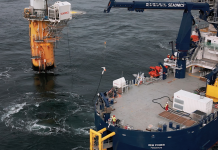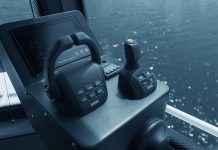A recent study performed by the National Wind Technology Center (NWTC) at the National Renewable Energy Laboratory (NREL) is helping Norway-based Statoil analyze key issues related to the installation of what has the potential to be the world’s first multi-turbine floating offshore array.
Statoil deployed the first spar-based system called Hywind Demo in 2009, which is still operating today. The company partnered with NREL from March 2013 to March 2015 to analyze the Hywind technology as applied to U.S. waters.
Floating offshore wind turbine technology has significant potential for being a clean, sustainable source of energy. The technology is feasible above transitional water depths of 50 meters, where fixed-bottom structures are economically challenged. Floating wind turbines have the unique ability to access robust wind resources that are often higher and more available than in shallower water — thereby lowering the cost of energy by increasing power production.
Senu Sirnivas, a principal engineer at the NWTC, has thoroughly enjoyed the opportunity to collaborate with a leading developer in an emerging industry.
“Working with Statoil has been an incredible experience,” Sirnivas said. “At NREL, we have developed several tools to evaluate offshore wind system performance and costs. Our team was very encouraged to know that Statoil saw value in our work, and that these NREL tools and analyses were helping inform what can be the first multi-turbine floating wind turbine array. Developing software tools that are at the cutting edge was thrilling.
“Through this unique experience, we were able to get practical and experience-based feedback, which is going to inform our future work.”
The original study in budget period 1 used a 3-MW Hywind system and focused on design and analysis, turbine size-up scaling, the mooring system, instrumentation, data acquisition, and economic analysis. During budget period 2, the focus shifted to a 6-MW Hywind system and included design and analysis, wake modeling, and geo-spatio-economic assessment.
 Design and Analysis
Design and Analysis
NREL researchers and University of Colorado-Boulder interns conducted multiple design analyses of Hywind’s technology. Using Statoil’s 6-MW turbine design and control algorithm, NREL built a model of the same size in FASTv7 (FAST7), an NREL software program that models the dynamic forces of wind turbines. The researchers investigated four design load cases: power production, power production plus occurrence of fault, parked (standstill or idling), and parked plus fault conditions. This work found limiting loads for all of the studied cases for the Hywind technology, which Statoil may use to compare against their own findings.
Wake Modeling
The wake modeling portion of the study focused on how the wakes of multiple turbines in an array affect the fatigue loads on downstream turbines. NREL used the FAST7 model built for the design and analysis work package with NREL’s high-fidelity simulation tool, Simulator for Wind Farm Applications. The simulations were performed using two high-performance computing systems: Peregrine at NREL and Hexagon at the University of Bergen.
The researchers found that the effect of wake-generated turbulence on the fatigue loads on turbines’ mooring lines persisted even at 10 rotor diameters downstream, whereas the load intensities for the turbine blades and the tower decayed with the wake. In addition, researchers used a reduced-order model for wind plant optimization to investigate optimally fixed yaw angles for a 10-by-10 turbine array with 7-rotor-diameter spacing and discovered a 2.4 percent improvement in overall power generation based on a mean hub-height wind speed of 8 meters per second. Such an improvement could mean a significant increase in revenue or a savings to customers for a full-scale wind plant.
Resource Assessment
NREL also conducted a national economic analysis for Statoil to provide them with information to help understand the market for the Hywind technology in the U.S. The analysis used a new geo-spatio-economic methodology that NREL developed to assess how resource variability in different water depths can influence the levelized cost of energy for different offshore wind technologies. The results of the analysis suggest that there are many suitable U.S. locations where Hywind technology could be deployed, and that innovative logistics strategies under consideration by Statoil could open additional areas to development.
NREL presented Statoil with a report on each of its work packages, and the company may use the results of the collaboration to guide its future projects. NREL researchers have also presented Statoil with proposals for future collaborative efforts.
— Source: NREL



























